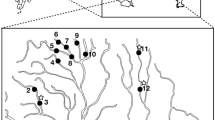Abstract
Metal complexation by natural ligands is important for metal transport and distribution in surface and ground water. The goal of the work was to study the ligand exchange rate for two important metal ions in natural aquatic systems (Al, Fe) was determined using EDTA and natural organic matter (NOM) of humic type as ligands.
After adding EDTA to a solution containing metal-NOM complexes, these complexes dissociated and metal-EDTA complexes were formed. Metal-NOM complexes were separated from metal-EDTA complexes with the help of size-exclusion chromatography and detected by on-line inductively coupled plasmamass spectrometry (ICP-MS). Injecting the samples into the system over time after addition of EDTA allowed us to measure the rate of the exchange of NOM by EDTA.
The experiments could be well described with a first-order rate law assuming that the dissociation of the metal-NOM complexes is the rate-determining step. The exchange rate of Fe was found to be faster than that of Al. This corresponds well with the exchange rate of water molecules from the coordination sphere of the metal ions, which is also faster for Fe than for Al. Furthermore, the UV and the fluorescence signal of the chromatograms were measured.
The results indicate that no disaggregation of NOM molecules took place, although about 75–85% of the aggregate-forming metal ions exchanged NOM by EDTA in their coordination sphere. This suggests clearly the fundamental role of NOM in colloidal transport of metals and in their bioavailability.
Similar content being viewed by others
References
Artinger R, Kienzler B, Schüßler W, Kim JI (1998): Effects of humic substances on the 241Am migration in a sandy aquifer: Column experiments with Gorleben groundwater/sediment systems. J Cont Hydrol 35, 261–275
Chen Y, Clapp CE, Magen H, Cline VW (2000): Stimulation of plant growth by humic substances: Effects of iron availability. Special Publications of the Royal Society of Chemistry 247, 255–264
Hering JG, Morel FMM (1990): The kinetics of trace metal complexation: Implications for metal reactivity in natural waters. In: Stumm W (ed) Aquatic Chemical Kinetics, pp 145–172. John Wiley & Sons
Perminova IV, Frimmel FH, Kovalevskii DV, Abbt-Braun G, Kudryavtsev AV, Hesse S (1998): Development of a predictive model for calculation of molecular weight of humic substances. Wat Res 32(3) 872–881
Schmitt D, Müller MB, Frimmel FH (2000): Metal distribution in different size fractions of natural organic matter. Acta Hydrochim Hydrobiol 28 (7) 400–410
Schüßler W, Artinger R, Kienzler B, Kim JI (2000): Conceptual modeling of the humic colloid-borne americium(III) migration by a kinetic approach. Environ Sci Technol 23 (12) 2608–2611
Sharpless CM, McGown LB (1999): Effects of aluminum-induced aggregation on the fluorescence of humic substances. Environ Sci Technol 33(18) 3264–3270
Specht CH, Frimmel FH (2000): Specific interactions of organic substances in size- exclusion chromatography. Environ Sci Technol 34 (11) 2361–2366
Stumm W (1992): Chemistry of the Solid-Water Interface. John Wiley & Sons, New York
Stumm W, Morgan JJ (1996): Aquatic Chemistry. John Wiley & Sons, New York
Vogl J, Heumann KG (1997): Determination of heavy metal complexes with humic substances by HPLC/ICP-MS coupling using isotope dilution technique. Fres J Anal Chem 359, 438–441
Wershaw RL (1999): Molecular aggregation of humic substances. Soil Science 164(11) 803–813
Author information
Authors and Affiliations
Corresponding author
Rights and permissions
About this article
Cite this article
Schmitt, D., Frimmel, F.H. Ligand exchange rate of metal-nom complexes by EDTA. Environ Sci & Pollut Res 10, 9–12 (2003). https://doi.org/10.1065/espr2002.08.130
Received:
Accepted:
Issue Date:
DOI: https://doi.org/10.1065/espr2002.08.130




